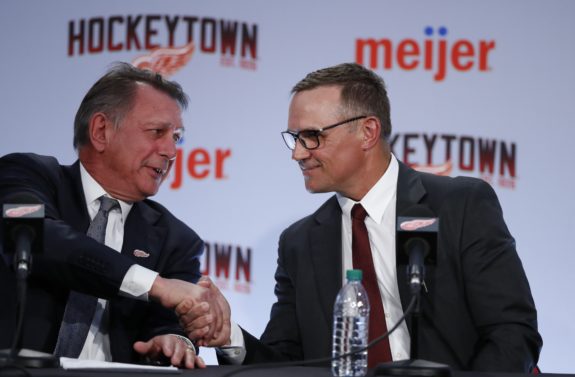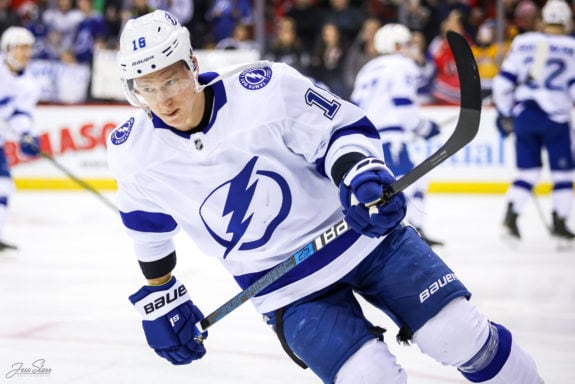If the speculation holds true that the 2020-21 salary cap upper limit will remain at $81.5 million, the Detroit Red Wings have a tremendous opportunity in front of them.
Only a few short years ago, the Red Wings were in salary cap purgatory. They were constantly among the top spenders, but the on-ice product’s return on investment dwindled over time.
Now, Steve Yzerman and the Red Wings have plenty of cap space to work with – unlike a handful of teams. With extra room in the budget, it’s essential that they identify other teams’ self-inflicted wounds and use their cap space as a competitive advantage.
Related: Red Wings: Draft Lottery Fallout
Cap Space as an Asset
There are a few ways that the Red Wings can take advantage of their cap space. The first and obvious way is to acquire players from cash-strapped teams who can no longer afford them. Trading said players alleviates cap issues and allows the trading team to get something in return. This is preferred to buying out a player and being stuck with a cap hit from the transaction.

The Red Wings, on the other hand, get to acquire a solid player for less than his actual value. It’s the same thinking as grocery stores putting items on sale when they have too large of an inventory. They’re motivated to reduce inventory before losing it for nothing (seeing it expire). Buyers are motivated to take advantage of the lower-than-usual price.
The second way to leverage cap space is to drive up the price of free agents – within limit. Remember when Yzerman drove up the asking price for Erik Karlsson at the 2018 Trade Deadline only to back-door the market and acquire Ryan McDonagh? He can do something similar this offseason and force teams to bid high on free agents. As a result, some teams will miss out on needed depth and others will be hampered by bloated contracts down the road. The Red Wings could also be selective and offer a quality player an above-market-value contract—albeit one with short term—to bolster their lineup.
Red Wings’ Troubled Targets
Sticking with the first approach of acquiring players who can no longer be afforded, there are a few teams that stick out as prime targets:
- Pittsburgh Penguins – 15 NHLers under contract; $13,224,825 in cap space
- St. Louis Blues – 20 NHLers under contract; $2,047,501 in cap space
- Tampa Bay Lightning – 15 NHLers under contract; $5,333,334 in cap space
- Toronto Maple Leafs – 16 NHLers under contract; $4,591,467 in cap space
Tampa Bay immediately jumps off the board as a team in peril. They have six RFAs to sign, including core players Anthony Cirelli, Mikhail Sergachev, and Erik Cernak. Then there’s still a couple more roster spots to fill. Something’s got to give.
Yzerman could call up his old team and attempt to acquire Yanni Gourde, Ondrej Palat, or Tyler Johnson below their market value. Alex Killorn and Brayden Coburn are options too, though less appealing than the initial three players I listed.

The other three teams have goalies either currently taking up—or will soon take up—significant cap space. In Pittsburgh, both Tristan Jarry and Matt Murray will be RFAs after the season and should command raises. Murray, in particular, could be an intriguing option for the Red Wings. Jake Allen and Jordan Binnington will both be UFAs after next season and presently take up $8.75 million of St. Louis’ salary cap. And in Toronto, the Maple Leafs will need all the cap space they can get to round out their roster. Jack Campbell’s $1.65 million cap hit suddenly seems like a lot to Leafs fans.
All four teams should be motivated to move players out as well. St. Louis still has to sign captain Alex Pietrangelo, who will be a UFA after this season. Pittsburgh needs space to bolster their roster with Sidney Crosby and Evgeni Malkin on the back-nine of their careers. Toronto and Tampa Bay must ice 18 skaters and two goalies, let alone a 23-man roster.
Depending on which players the Red Wings target, they could also pick up draft choices and/or prospects in addition; Carolina got a first-round pick for taking on Patrick Marleau’s cap hit last offseason. Plus, the Red Wings could also flip acquired players at the deadline for additional picks and prospects.
Related: The Grind Line: Red Wings’ Replacement for Jimmy Howard
Final Word
When considering his options, Yzerman needs to be very selective. Having cap space does not mean the Red Wings must do something with it. However, sitting on a gold mine of cap space without doing anything is a waste of an asset. Luckily for Yzerman and the Red Wings, they have a long offseason to determine what to do with their extra budget.
And don’t forget, the Seattle expansion draft is around the corner. Teams could lose quality players for nothing if they don’t act soon.
Salary cap data courtesy of CapFriendly.